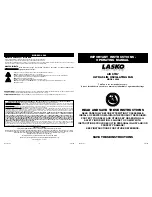
74
MAGNAMED TECNOLOGIA MÉDICA S/A
V-SIMV
–
Volume Synchronized Intermittent Mandatory Ventilation
As soon as all ventilation parameters are set in the ventilator, it calculates the T
INSP
and T
EXP
by function
of Flow, Pause, Waveform, and Rate, thus obtaining all the ventilation control times.
1. Represents a VCV cycle (controlled volume) with inspiratory pause;
2. Represents a spontaneous breathing cycle by the patient WITHOUT SUPPORTING PRESSURE;
3. Represents a VCV cycle (controlled volume) after the SIMV Period;
4. Represents a spontaneous breathing cycle by the patient WITH SUPPORTING PRESSURE,
whose cycling occurs by flow, when this reaches a value between 25% and 75% of the read peak
value.
5.
The peak’s flow percentage in which the cycling from inspiratory phase to expiratory phase occur
is programmable. The rise time (T
RISE
) also applies to support pressure (refer to PCV).
6. If the patient realizes inspiratory effort, a window will appear at the end of the SIMV (T
SIMV
) period
in order to synchronize the controlled ventilation cycle, which is “opened” from 0.75 x(T
SIMV
). In
other words, a synchronism window opens during the last fourth of the SIMV period during the
mandatory ventilation cycle. The information regarding what type of trigger activated the
inspiratory cycle is informed on the screen’s messages and status area.
•
The support pressure adjusted
(ΔPS) is
a value above PEEP. Therefore, the support inspiratory
















































